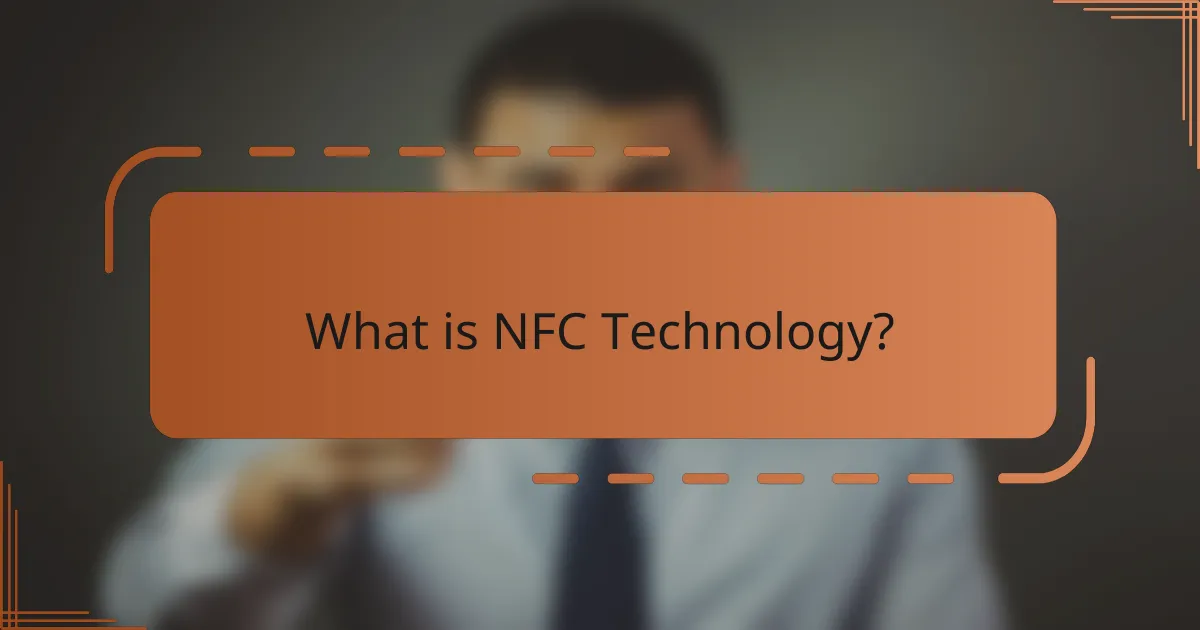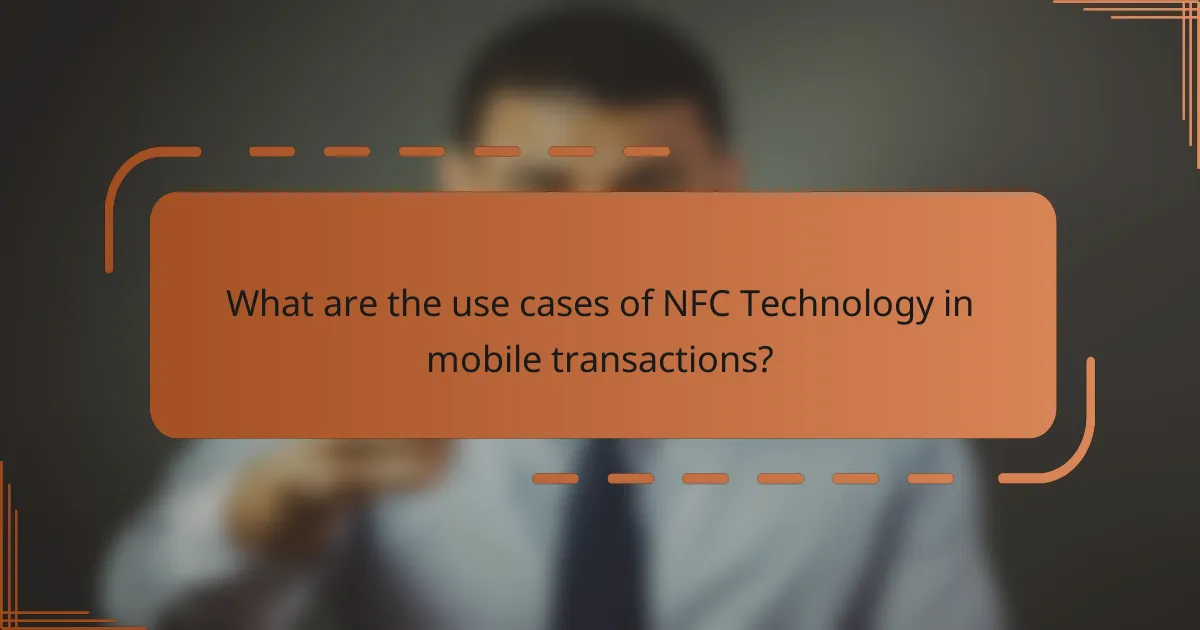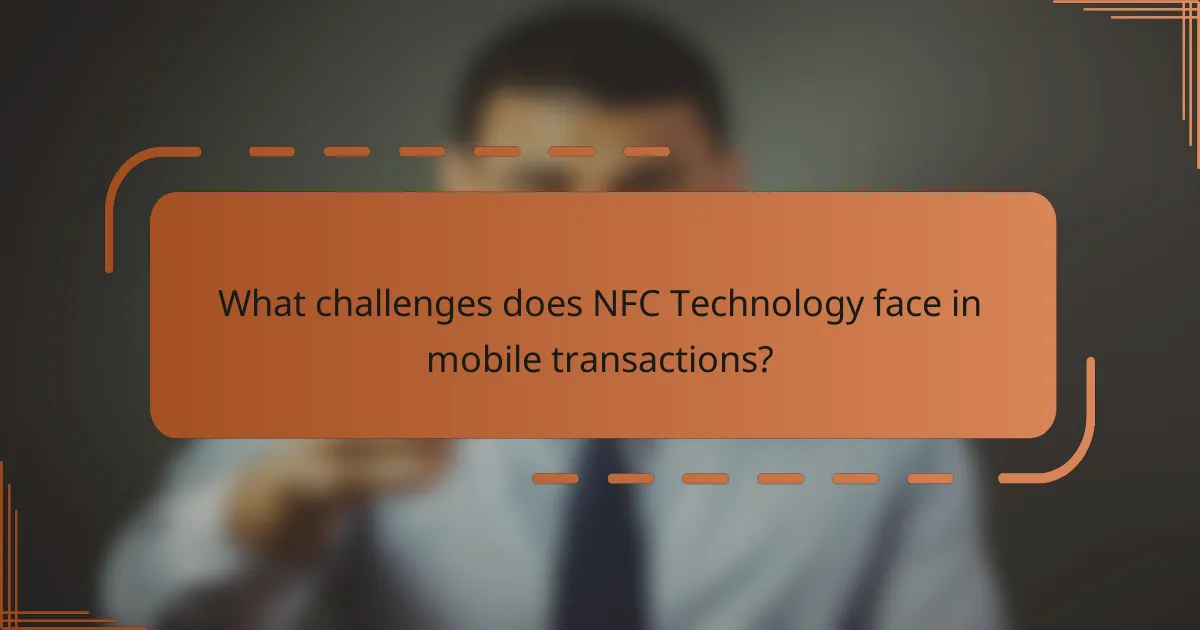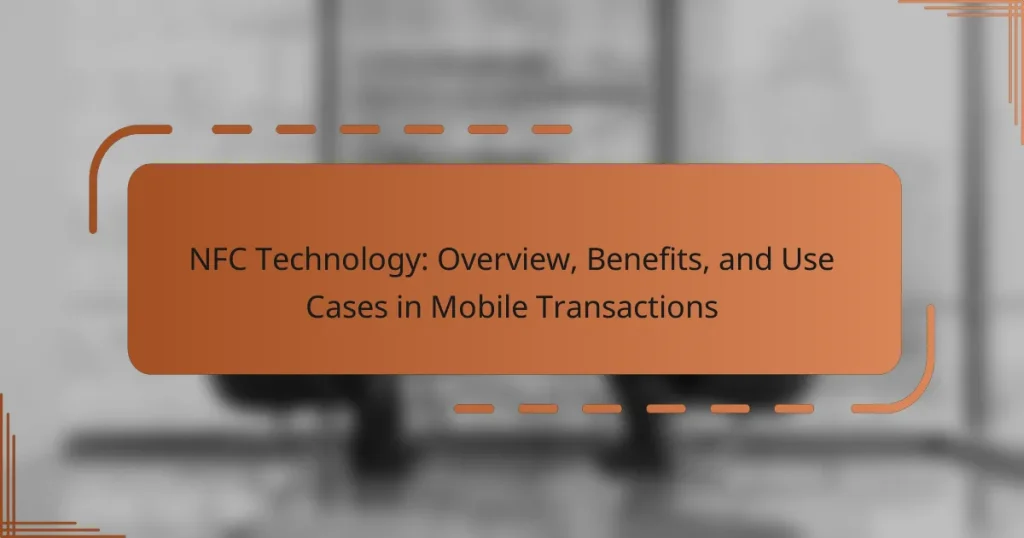NFC technology, or Near Field Communication technology, is a wireless communication protocol that enables short-range interactions between compatible devices, typically within 4 centimeters. This technology is predominantly used for mobile payments, allowing users to complete transactions by tapping their devices, and it also facilitates data exchange, such as sharing contact information and pairing devices. The article explores the various applications of NFC technology in mobile transactions, including contactless payments, mobile wallets, public transportation ticketing, loyalty programs, and peer-to-peer money transfers. Additionally, it addresses the challenges NFC technology faces, including security concerns, compatibility issues, user adoption, transaction limits, infrastructure limitations, and regulatory hurdles. Overall, the article provides a comprehensive overview of NFC technology, its benefits, and its role in enhancing mobile transaction experiences.

What is NFC Technology?
NFC technology, or Near Field Communication technology, is a set of communication protocols. It enables short-range wireless communication between compatible devices. Typically, this communication occurs at a distance of 4 centimeters or less. NFC technology is commonly used in mobile payments, allowing users to make transactions by tapping their devices. It also facilitates data exchange, such as sharing contact information or pairing devices. The technology operates at a frequency of 13.56 MHz and supports data transfer rates up to 424 kbit/s. NFC is widely adopted in smartphones, smartwatches, and contactless payment cards. Its ease of use and convenience have contributed to its popularity in various applications.
How does NFC Technology work?
NFC technology works by enabling short-range wireless communication between devices. It uses electromagnetic fields to transfer data over distances of about 4 inches or less. NFC operates at a frequency of 13.56 MHz. It allows devices to communicate when they are in close proximity. The technology supports two modes: active and passive. In active mode, both devices generate their own fields. In passive mode, one device generates a field while the other uses it to communicate. NFC is commonly used for contactless payments and data exchange. It is secure due to its short range, which minimizes interception risks.
What are the key components of NFC Technology?
The key components of NFC technology are the NFC chip, antenna, and software protocols. The NFC chip processes data and manages communication between devices. The antenna facilitates wireless communication by transmitting and receiving radio frequency signals. Software protocols govern how devices interact, ensuring secure and efficient data exchange. These components work together to enable functions like contactless payments and data sharing. NFC technology operates within a short range, typically up to 4 centimeters, ensuring secure transactions.
How do these components interact in NFC transactions?
NFC transactions involve several key components: an NFC-enabled device, a reader, and the data being transmitted. The NFC-enabled device, such as a smartphone, generates a radio frequency signal. This signal activates the NFC reader, which is typically located at a point of sale. Once activated, the two devices establish a communication link. The NFC-enabled device then transmits data, such as payment information, to the reader. This data transfer occurs within a few centimeters, ensuring security. The reader processes the received data and completes the transaction. This interaction is facilitated by protocols defined by NFC standards, ensuring compatibility and security.
What are the main benefits of NFC Technology?
NFC technology offers several key benefits. It enables contactless payments, enhancing convenience for users. Transactions are completed quickly, often in seconds. NFC technology increases security through encryption and tokenization. This reduces the risk of fraud compared to traditional payment methods. It also supports a wide range of applications beyond payments, such as ticketing and access control. NFC devices can easily pair with other devices, simplifying data sharing. According to a study by MarketsandMarkets, the NFC market is expected to grow significantly, indicating its increasing adoption and relevance.
How does NFC Technology enhance user convenience?
NFC technology enhances user convenience by enabling quick and seamless transactions. Users can make payments by simply tapping their devices on a compatible terminal. This eliminates the need for cash or physical cards, streamlining the payment process. NFC also supports contactless data transfer, allowing users to share information effortlessly. For instance, users can exchange contact details or access tickets with a tap. Additionally, NFC technology provides enhanced security features. Transactions are encrypted, reducing the risk of fraud. According to a study by Juniper Research, contactless payment transactions are expected to reach $6 trillion by 2024, showcasing the growing preference for NFC convenience.
What security features are integrated into NFC Technology?
NFC technology integrates several security features to protect data during transactions. These features include encryption, which secures the communication between devices. Additionally, NFC employs tokenization, replacing sensitive data with unique identifiers. Authentication mechanisms verify the identity of devices involved in the transaction. Secure channels are established to prevent eavesdropping and tampering. Many NFC systems also support password protection and biometric authentication for added security. According to the NFC Forum, these measures enhance the safety of mobile transactions significantly.

What are the use cases of NFC Technology in mobile transactions?
NFC technology is utilized in various mobile transaction use cases. Contactless payments are the most common application, allowing users to pay at retail locations by tapping their devices. Mobile wallets, like Apple Pay and Google Pay, leverage NFC for secure transactions. Additionally, NFC is used for ticketing in public transportation systems, enabling users to tap their devices for entry. Loyalty programs also incorporate NFC, allowing customers to earn points by tapping their phones at checkout. Peer-to-peer transactions are facilitated through NFC, enabling users to send money by simply tapping their devices together. Lastly, NFC tags can be used for marketing purposes, directing users to websites or promotions when scanned. These use cases highlight the versatility and convenience of NFC technology in mobile transactions.
How is NFC Technology utilized in retail environments?
NFC technology is utilized in retail environments primarily for contactless payments. Customers can make purchases by tapping their NFC-enabled devices on payment terminals. This process enhances transaction speed and convenience. Retailers benefit from reduced checkout times, leading to improved customer satisfaction. Additionally, NFC technology can facilitate loyalty programs and promotional offers through digital wallets. Studies show that 55% of consumers prefer contactless payments for their speed and hygiene. NFC also enables seamless inventory management through smart tags. Overall, NFC technology streamlines operations and enhances the shopping experience in retail settings.
What types of payments can be made using NFC Technology?
NFC technology enables several types of payments. Contactless credit and debit card payments are common. Mobile wallets like Apple Pay and Google Pay also utilize NFC for transactions. Peer-to-peer payment systems, such as Venmo and Cash App, can use NFC for quick transfers. Retailers often support NFC for loyalty program payments. Public transportation systems increasingly accept NFC for fare payments. These payment types leverage NFC’s secure, fast, and convenient features.
How does NFC Technology improve the checkout experience?
NFC technology improves the checkout experience by enabling fast and contactless payments. This technology allows devices to communicate wirelessly over short distances. Customers can simply tap their smartphones or cards on a terminal. This action significantly reduces waiting times during transactions. According to a study by Juniper Research, contactless payments are expected to reach $6 trillion by 2024. NFC transactions also enhance security through encryption and tokenization. This minimizes the risk of fraud compared to traditional payment methods. Additionally, NFC technology streamlines the checkout process by integrating loyalty programs and discounts directly into the payment system.
What are the applications of NFC Technology beyond payments?
NFC technology has various applications beyond payments. It is used for data transfer between devices, such as sharing contacts or files. NFC tags can store information for marketing purposes, enabling consumers to access product details or promotions. It is also utilized in access control systems, allowing secure entry to buildings or events. NFC technology enables smart posters that provide interactive experiences when scanned. Additionally, it is applied in ticketing for public transport, simplifying the boarding process. NFC can facilitate pairing devices, such as headphones or speakers, enhancing user convenience. These applications demonstrate the versatility of NFC technology in various sectors.
How does NFC Technology facilitate loyalty programs?
NFC technology facilitates loyalty programs by enabling seamless and quick transactions. Customers can easily tap their NFC-enabled devices at points of sale to earn or redeem loyalty points. This process reduces the friction typically associated with loyalty program participation. NFC technology also allows for real-time updates to loyalty accounts. As a result, customers receive instant feedback on their points balance or rewards. Additionally, NFC can enhance personalized marketing efforts by providing tailored offers based on customer behavior. Studies show that 70% of consumers prefer mobile wallets for loyalty programs due to their convenience. This preference drives higher customer engagement and retention in loyalty programs.
What role does NFC Technology play in ticketing and access control?
NFC technology enables seamless ticketing and access control through contactless communication. It allows users to tap their devices on NFC-enabled readers to gain entry. This method enhances user convenience and speeds up the entry process. NFC ticketing reduces the need for physical tickets, minimizing waste and fraud. It also allows for real-time validation of tickets at events. According to a study by Juniper Research, NFC transactions in ticketing are expected to surpass 1 billion by 2025. This growth indicates the increasing adoption of NFC for secure and efficient access control solutions.

What challenges does NFC Technology face in mobile transactions?
NFC technology faces several challenges in mobile transactions. Security concerns are significant, as NFC can be susceptible to eavesdropping and data interception. Compatibility issues arise due to varying standards among devices and platforms. User adoption is another challenge, as many consumers are unfamiliar with NFC technology. Additionally, transaction limits can restrict the amount that can be transferred via NFC. Infrastructure limitations exist, as not all merchants have NFC-enabled payment systems. Lastly, regulatory hurdles can complicate the implementation of NFC solutions in certain regions. These challenges hinder the widespread adoption and effectiveness of NFC technology in mobile transactions.
What are the limitations of NFC Technology?
NFC technology has several limitations. One limitation is its short range, typically requiring devices to be within 4 centimeters to communicate. This restricts its usability in scenarios where distance is a factor. Another limitation is the low data transfer rate, which is around 424 kbit/s. This speed is significantly slower compared to other wireless technologies like Bluetooth. NFC also has limited compatibility with older devices. Many older smartphones do not support NFC, limiting its adoption. Additionally, NFC transactions require both devices to be powered on and unlocked. This can hinder usability in fast-paced environments. Security concerns also exist, as NFC is susceptible to eavesdropping and relay attacks. These issues highlight the challenges in implementing NFC technology widely.
How does range affect NFC Technology’s usability?
Range significantly affects NFC Technology’s usability by limiting the distance over which data can be transmitted. NFC operates effectively at a range of up to 4 centimeters. This short range enhances security by requiring close proximity for communication. Users must physically bring their devices close together to initiate transactions. Consequently, this limitation encourages intentional interactions, reducing the risk of unauthorized access. The defined range also impacts use cases, such as mobile payments and ticketing. These applications rely on quick, secure exchanges that benefit from the short operational distance.
What compatibility issues exist with NFC devices?
NFC devices may face compatibility issues due to different NFC standards. Not all devices support the same NFC protocols, leading to communication failures. Some devices may only work with specific NFC tags or formats. Additionally, hardware limitations can restrict functionality across different brands. Software compatibility, including operating system versions, can also impact performance. Devices may not support all NFC features, such as peer-to-peer communication. Furthermore, older NFC devices may not interact effectively with newer models. These factors contribute to the overall challenges in achieving seamless NFC interactions.
What are best practices for implementing NFC Technology in mobile transactions?
Implementing NFC technology in mobile transactions requires adherence to several best practices. First, ensure compliance with security standards such as EMVCo and PCI DSS. These standards protect sensitive payment information during transactions. Second, conduct thorough testing of the NFC-enabled devices and applications. Testing ensures reliability and user experience.
Third, provide user education on how to use NFC technology safely. Users should understand how to activate NFC and complete transactions. Fourth, integrate multi-factor authentication for added security. This reduces the risk of unauthorized transactions.
Fifth, regularly update software to address vulnerabilities. Keeping software current is crucial for maintaining security. Lastly, collaborate with trusted payment service providers. This partnership enhances the credibility and reliability of the NFC payment system. These best practices collectively improve the effectiveness and security of NFC technology in mobile transactions.
How can businesses ensure secure NFC transactions?
Businesses can ensure secure NFC transactions by implementing strong encryption methods. Using end-to-end encryption protects sensitive data during transmission. Additionally, employing tokenization replaces card details with unique identifiers. Regularly updating software and firmware helps close security vulnerabilities. Training employees on security best practices reduces human error. Utilizing secure elements in devices enhances transaction safety. Monitoring transactions for unusual activity can detect fraud early. Finally, adhering to industry standards like EMVCo ensures compliance and security.
What strategies can enhance user adoption of NFC Technology?
User adoption of NFC technology can be enhanced through targeted strategies. Educating users about the convenience and security of NFC transactions is essential. Demonstrating real-world applications can increase familiarity and trust. Collaborating with retailers to offer incentives for using NFC can drive initial engagement. Ensuring compatibility with various devices broadens accessibility. Marketing campaigns can highlight the benefits of NFC, such as speed and ease of use. Providing user-friendly interfaces in apps can simplify the experience. Lastly, addressing security concerns with transparent communication can foster confidence in NFC technology.
What future trends can we expect for NFC Technology in mobile transactions?
Future trends for NFC technology in mobile transactions include increased adoption in various sectors. Retailers are expected to enhance customer experiences with personalized promotions via NFC. Contactless payments will grow, driven by consumer demand for convenience and speed. Security features will advance, incorporating biometric authentication for safer transactions. Integration with IoT devices will enable seamless payments across multiple platforms. The rise of digital wallets will further popularize NFC, as users prefer mobile solutions over traditional methods. According to a report by MarketsandMarkets, the NFC market is projected to reach $34.3 billion by 2026, indicating robust growth in this area.
NFC Technology, or Near Field Communication technology, facilitates short-range wireless communication between devices, typically within 4 centimeters. This article provides an overview of NFC technology, detailing its functionality, key components, and security features. It explores various use cases in mobile transactions, including contactless payments, ticketing, and loyalty programs, while also addressing challenges such as security concerns and compatibility issues. Additionally, the article highlights best practices for implementing NFC technology and discusses future trends in its adoption and application across different sectors.


